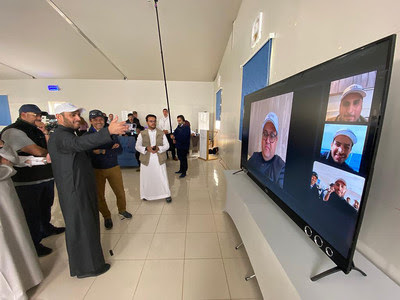
Cambridge-based company, Stratospheric Platforms has announced the first successful demonstration of 5G broadband connectivity between a “stratospheric 5G mast” flying at 45,000 ft and a retail 5G smartphone, beating aerospace rivals to the world first.

The landmark telecoms trial was run in collaboration with the Saudi Communications and Information Technology Commission (CITC) in the airspace above The Red Sea Project. Engineers connected to the local telecoms network, completing tests between a 5G base station, flying stratospheric antenna, and retail mobile devices.
Leader in 5G development
The trial confirmed Stratospheric Platforms as a leader in the development of global 5G Internet and communications services, projecting a 5G signal to an area of 450km2, and proving the technology can achieve mobile download speeds comparable to terrestrial 5G networks and at a significantly lower cost.
The joint team established three-way video calls between the land-based test site, a mobile device operated from a boat and a control site located 950 km away. Further land and heliborne tests demonstrated a user could stream 4K video to a mobile phone with an average latency of 1 millisecond above network speed. Signal strength trials, using a 5G enabled device moving at 100 km/h, proved full interoperability with ground-based masts and a consistent ‘five bars’ in known white spots.
Richard Deakin, CEO of Stratospheric Platforms said:
“Stratospheric Platforms has achieved a world-first. This is a momentous event for the global telecoms industry proving that a 5G telecoms mast flying near the top of the earth’s atmosphere can deliver stable broadband 5G internet to serve mobile users with ubiquitous, high-speed internet, over vast areas.”
He added, that:
“the trial has proved that 5G can be reliably beamed down from an airborne antenna and is indistinguishable from ground-based mobile networks. Our hydrogen-powered ‘Stratomast’ High Altitude Platform currently under development, will be able to fly for a week without refuelling and cover an area of 15,000 km2 using one antenna.”The successful demonstration that a High Altitude Platform can deliver 5G Internet from the stratosphere means that mobile users can look forward to the capability of 5G mobile internet, even in the remotest areas of the world.
CITC Governor, H.E. Dr Mohammed Altamimi commented: “the Kingdom of Saudi Arabia is at the cutting edge of technological innovation and our partnership with Stratospheric Platforms’ with the support of the Red Sea Project and General Authority of Civil Aviation (GACA) has demonstrated how we can deliver ‘always on’, ultra-fast broadband to areas without ground based 5G masts.”





